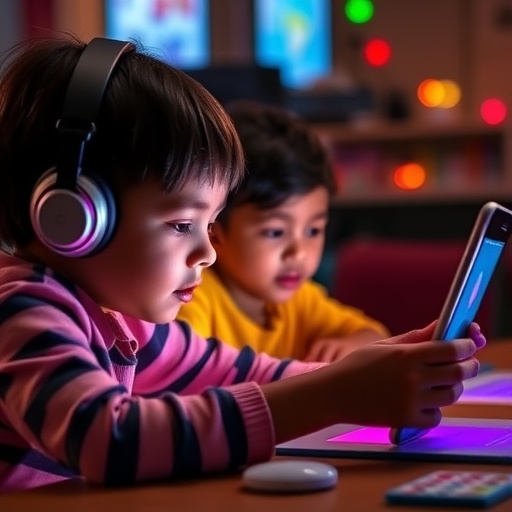In the ever-evolving landscape of childhood development, a robust discourse is emerging surrounding the intersection of Adverse Childhood Experiences (ACEs), Positive Childhood Experiences (PCEs), and the pervasive influence of digital media on children and adolescents in the United States. The findings from a comprehensive study addressing these critical dimensions elucidate how early experiences shape the digital behavior of younger populations. Given the ubiquitous nature of technology in modern society, understanding this relationship may provide pivotal insights for parents, educators, and policymakers as they seek to navigate the complexities of child development in the digital age.
At the core of this research is the profound impact that adverse experiences during critical developmental stages can have on a child’s psychological well-being. Adverse Childhood Experiences, which include a range of traumatic events such as abuse, neglect, and household dysfunction, have been linked to numerous long-term health outcomes. These experiences create a landscape that may predispose children to mental health challenges, thereby influencing their interactions with technology—an increasingly prominent aspect of daily life. The study aims to bridge the gap between the understanding of these adverse experiences and their consequences on digital media usage among youth.
In contrast to the detrimental effects of ACEs, Positive Childhood Experiences offer a counterbalance. These experiences—characterized by supportive relationships, emotional safety, and opportunities for engagement—have a distinctly positive correlation with resilient development. The interplay between PCEs and the use of digital media warrants critical examination, as it can serve as a buffer against the negative impacts of adversity. Children equipped with positive experiences may utilize technology in more constructive and creative ways, harnessing its potential for enhanced learning and social connectivity.
As technology becomes increasingly ingrained in the fabric of youth culture, understanding how it affects the mental health and well-being of children is paramount. The research highlights that digital media use is not inherently harmful; instead, it is the context in which it is used that can determine positive or negative outcomes. For instance, children who engage with technology through educational programs or supportive online communities may experience enhanced learning opportunities, whereas those exposed to harmful online content or excessive screen time may face increasing risks of anxiety, depression, and social isolation.
The study’s findings also emphasize the disparities in digital media use based on socioeconomic factors, geographic locations, and access to resources. Families navigating lower socioeconomic statuses may find themselves in a precarious situation, where the lack of access to positive digital experiences exacerbates the effects of ACEs. This begs critical questions about equity in technology use and the role of community support systems in ensuring that all children can benefit from positive online environments, particularly those most vulnerable to the influences of adversity.
Furthermore, the research outlines various strategies that can facilitate healthier digital media use among youth. Recommendations include cultivating digital literacy—a skill that enables children to critically evaluate the information they encounter online and navigate social media landscapes with intention. Programs aimed at enhancing both social and digital skills can empower children to engage with technology as a tool for growth rather than a source of distress.
The implications of these findings extend beyond individual family units and into the educational systems and policy frameworks that govern children’s interactions with media. Educators are urged to integrate discussions about digital media into curricula, raising awareness about both its potential benefits and risks. By doing so, schools can serve as safe spaces where children learn to leverage technology positively while developing critical coping mechanisms that mitigate the effects of any adverse experiences they may face.
In addition to educational initiatives, there exists a call for broader policy reforms that acknowledge the role technology plays in children’s lives. Advocating for regulations that promote safe online environments and prioritize the mental health of youth is essential. This includes protecting children from harmful content and ensuring that there are accessible resources for families to navigate the complexities of digital media effectively.
On a community level, fostering partnerships between families, schools, and local organizations can bolster efforts to provide wholesome digital experiences. Community programs that offer support, education, and resources can prove invaluable in creating a more supportive backdrop for children grappling with the effects of ACEs. Such initiatives can also promote the sharing of PCEs, ensuring that all children can benefit from the safe and constructive uses of technology.
In sum, the interplay between Adverse Childhood Experiences, Positive Childhood Experiences, and digital media usage paints a nuanced picture of youth development. As technology continues to evolve and infiltrate various aspects of life, it remains a double-edged sword. The key to maximizing the positives while mitigating the negatives lies in intentionality—approaching digital media consumption with mindfulness and a genuine desire to promote mental health and resilience among youth.
As more research continues to unfold, it becomes clear that understanding this dynamic will be crucial both for responding to current challenges and for preparing future generations for a world deeply entwined with technology. Advocates, educators, and parents alike must collaborate to ensure that as children navigate their formative years, they do so equipped with the necessary tools to thrive in an increasingly digital age, ultimately paving the way for healthier outcomes.
Subject of Research: The interaction between Adverse Childhood Experiences, Positive Childhood Experiences, and digital media use among children and adolescents.
Article Title: Adverse Childhood Experiences, Positive Childhood Experiences, and Digital Media Use among Children and Adolescents in the United States.
Article References:
Crouch, E., Shapiro, C., Boswell, E. et al. Adverse Childhood Experiences, Positive Childhood Experiences, and Digital Media Use among Children and Adolescents in the United States.
Journ Child Adol Trauma (2025). https://doi.org/10.1007/s40653-025-00785-z
Image Credits: AI Generated
DOI: 10.1007/s40653-025-00785-z
Keywords: Adverse Childhood Experiences, Positive Childhood Experiences, Digital Media, Children, Adolescents, Mental Health, Technology, Resilience, Education, Policy.




